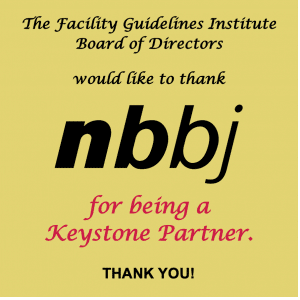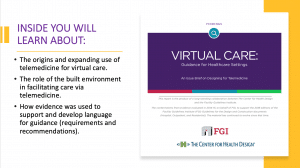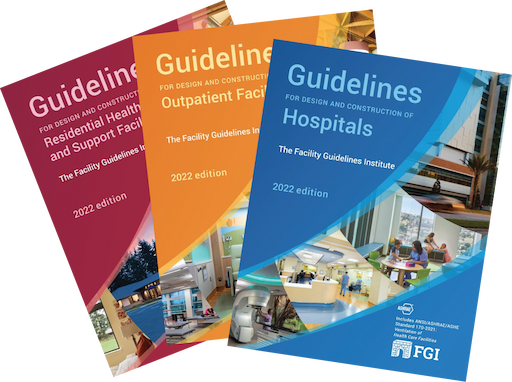FGI Bulletin #15
2022 Guidelines Comment Period Closes
The recent comment period on the draft 2022 Guidelines documents resulted in 578 comments across the three documents. A special thanks to those of you who took time to review the drafts and provide input on proposed changes!
Submitted comments are now being reviewed and voted on by the Health Guidelines Revision Committee (HGRC). Approved comments will be incorporated into the 2022 Guidelines. HGRC activity will continue through April 2021.
Keep Up with Newly Released Errata
On November 16, 2020, updated errata sheets were published for both the 2018 Hospital and Outpatient Guidelines. The most significant correction clarifies the location of support areas for Class 2 mobile/transportable medical units.
Also note an errata sheet has been published for the second printing of the Hospital document. Errata identified before its production were corrected in the second printing.
Remember to periodically check the Errata and Addenda page on the FGI website so you don’t miss corrections to errors found in the documents.
Interpretation re: AII Room in a Critical Access Hospital
FGI received an inquiry asking to clarify whether an airborne infection isolation room is required in the emergency department (ED) of a critical access hospital. The inquirer was concerned the hospital would not meet minimum requirements if it did not provide an AII room in the ED although two AII rooms were provided elsewhere in the facility. The Interpretation Committee determined there is no requirement in the 2018 Guidelines for an AII room in the ED of a critical access hospital nor, in fact, for the hospital itself; the need for an AII room in a critical access hospital is based on the infection control risk assessment performed by the health care organization.
This and other interpretations can be found in the 2018 Hospital Guidelines file at the bottom of this page on the FGI website.
Special Thanks to Our Keystone Partner
NBBJ’s in-kind contribution supports development of a Beyond Fundamentals resource that will provide explanatory diagrams for required room types in the 2018 Guidelines. Visit NBBJ’s website for more information about the firm.

Striving for Standardization in Health Care Facility Nomenclature
Early in 2020, representatives of FGI, the American Society for Health Care Engineering (ASHE), the Construction Specifications Institute, and the National Institutes of Health met to initiate a grassroots effort to align health care facility management classification schemas. In October, an article about the initiative was published in Health Facilities Management magazine.
The goal of this endeavor is to provide health care facility planners, designers, and operators with a common nomenclature to simplify maintenance of reliable building master records; streamline health care facility space and equipment management in the computerized maintenance management system (CMMS); increase compliance with regulatory requirements; provide consistent terminology in risk management; and support energy and operational benchmarking, increasing visibility into the total cost of ownership.
FGI and the American Society for Health Care Engineering (ASHE) each formed a group to undertake a formal review of the classifications and align them with the FGI Guidelines and other existing standards. The FGI Nomenclature Topic Group has wrapped up its review of the classifications for buildings, functional areas, and spaces in hospitals. Concurrently, a working group operating within ASHE’s Operational Excellence Committee has developed classifications for building systems and building system assets. A draft of the data classification format will be published for public review on the FGI and ASHE websites by December.
Telemedicine Issue Brief Now Available from CHD and FGI
The Center for Health Design (CHD), in partnership with FGI, has released “Virtual Care: Guidance for Healthcare Settings.” A result of the long-standing collaboration between FGI and CHD, the brief explores the origins and expanding use of telemedicine for virtual care, the role of the built environment in facilitating care via telemedicine, and how evidence was used to support and develop language for the Guidelines documents.

Telemedicine services have continually expanded over the last couple of decades, though the rate of growth has been slow to moderate. While there has been much excitement about the possibilities and promise of telemedicine in providing care to underserved and rural areas, challenges to implementation have been significant, due in part to Centers for Medicare and Medicaid Services (CMS) reimbursement regulations.
Now, with the COVID-19 pandemic, regulatory waivers and the potential benefits to both patients and clinicians have fostered unprecedented growth and, importantly, acceptance (and even preference) of virtual care over face-to-face office visits. According to one report cited in the brief, telemedicine usage increased as much as 4,330 percent in the few weeks after the pandemic was recognized.
This issue brief addresses several subjects, including space needs, privacy, acoustics, lighting, gaze angle and camera distance, interior surfaces, site identification, and equipment-associated issues. The brief is available for download from the Center for Health Design and FGI websites.
Update on FGI’s Upcoming Emergency Conditions Guidelines
Have you been curious about FGI’s upcoming emergency conditions (EC) white paper? We have good news! Through the collaborative efforts of more than 130 volunteers comprising the Emergency Conditions Committee (ECC), the EC white paper has gradually expanded into a book-length document offering guidance on a wide array of both design and operational considerations that will be applicable to health care facilities across the country. In an effort to include the most relevant and refined guidance possible, the FGI editorial board has scheduled a new release date for early 2021.
The expanded document will include a total of nine topic areas: safety risk assessment, surge capacity, alternate care sites, modular construction, weather/manmade event resiliency, renovations and future facilities, small and/or rural facilities, residential/adult care, and operational considerations. This increase in size and scope has not changed the overarching mission of the ECC, which is to develop recommendations based on case studies, best practices, historically effective solutions, and timely lessons learned.
Because this document will stand as part of FGI’s approach to help mitigate the challenges posed by both the COVID-19 pandemic and a variety of other emergency situations, feedback from the public will be instrumental in ensuring the production of a genuinely effective resource. The public will have an opportunity to review and comment on the document’s proposed standards over a three-month time period in 2021, and a revised version of these emergency conditions standards will be released in 2022. Be on the lookout for additional updates as we head into the new year!
